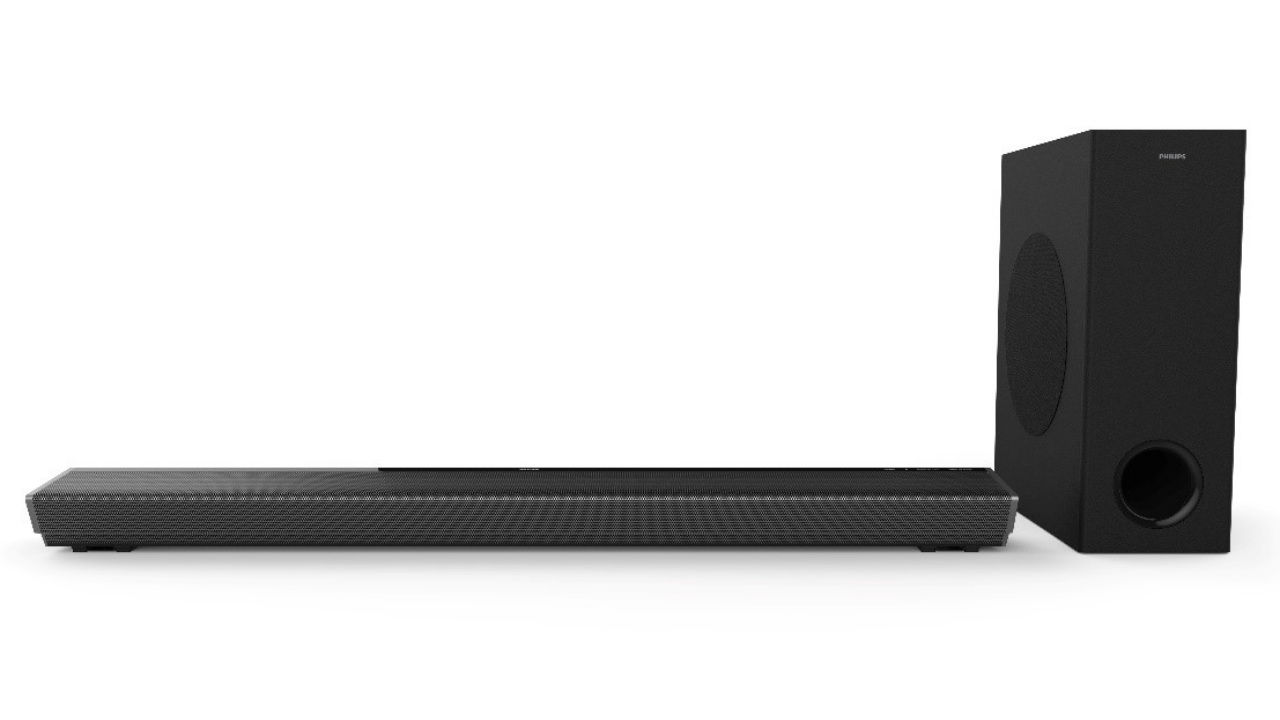
The Rs 30k to 40k price point seems to be the sweet spot for a good soundbar when it comes to performance and features. One can expect good connectivity options including 4K and HDR pass-through support, ample connectivity options and a wireless subwoofer. Some soundbars like the Yamaha YAS-209 also offer Alexa support built-in. We have also seen the Sony HT-G700 (review) bring with it a 3.1 channel design and support for Dolby Atmos. Today, we have with us yet another Dolby Atmos capable soundbar, the Philips 3.1 PB603 soundbar. Is it a worthy contender to the Sony, Yamaha and more bars in this price segment? Let’s find out.
Philips 3.1 soundbar PB603: What’s in the box
In the box, you get the soundbar itself, along with a wireless subwoofer. You also get the remote control in the box, an HDMI cable, an AUX cable and wall mounting brackets. You get 2 sets of power cables, which is nice. The remote control runs on a 3V button cell which is a departure from the AAA batteries we’ve seen on most soundbar remotes. More on that when we talk about the remote control. Overall, it’s nice to see an HDMI and AUX cable in the box. Even though the soundbar has an optical port, it doesn’t come with one in the box, and that’s ok. We prefer the inclusion of an HDMI cable in the box rather than an optical cable.
Philips 3.1 soundbar PB603: Connectivity options
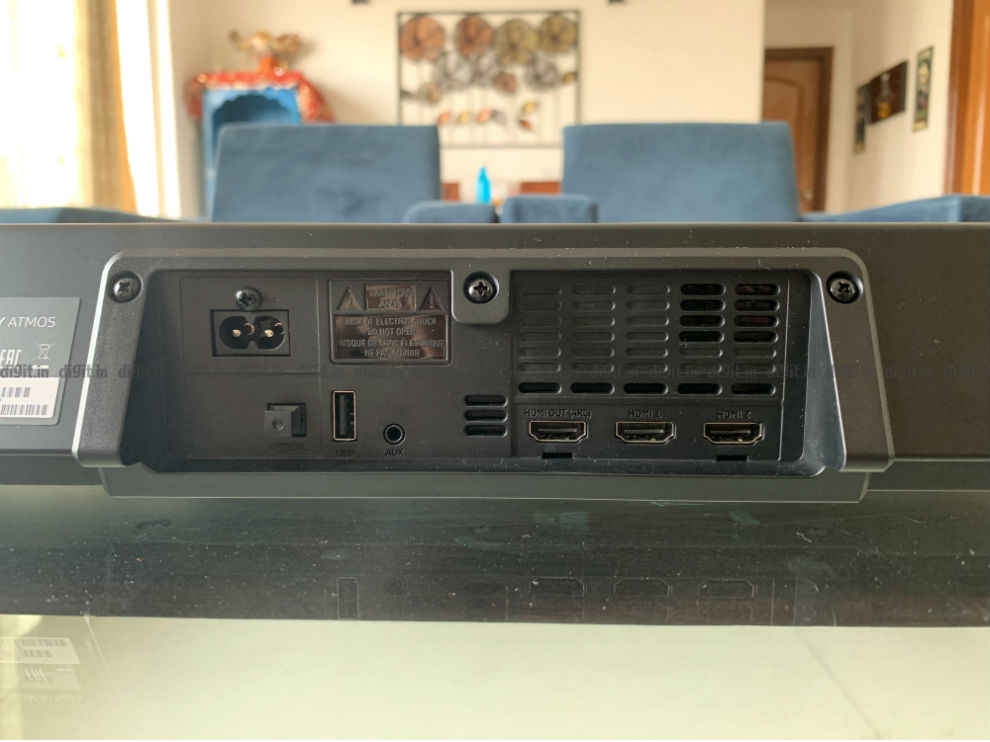
When it comes to connectivity options, the Philips 3.1 soundbar is quite loaded. At the back of the soundbar, we have the optical port, which comes with a really nice cover, a USB port and a 3.5mm AUX port. We also have 3 HDMI ports – 1 ARC port and two 4K pass-through ports. We have seen soundbars like the JBL SB450 (review) with 3 HDMI pass-through ports with 4K and HDR support (but no support for Dolby Vision). On the other hand, we have a soundbar like the Sony HT-G700 that has one HDMI pass-through port but with support for 4K and HDR including Dolby Vision. So, while it’s nice to see the Philips soundbar support 4K pass-through, the lack of HDR is missed. We also have the Yamaha YAS 209 bring with it a single 4K HDR pass-through port.
Setting up the Philips 3.1 soundbar PB603
Setting up the soundbar can be done in less than 5 minutes. The soundbar connects wirelessly to the subwoofer. Just connect the two to a power supply, connect the HDMI cable to the ARC port of your TV and to the HDMI out port on the soundbar and you are good to go. Just remember, that some TVs need you to manually change to ARC output in the sound settings. The soundbar and subwoofer connect wirelessly and there is a light at the back of the subwoofer to show you that it’s connected.

Philips 3.1 soundbar PB603 Build and design
A futuristic angular design is the first thing that will come to mind when you see the soundbar for the first time. It has a traditional rectangular form factor as we’ve seen on so many soundbars, but the soundbar looks like it’s leaning forward when you look at it from the side. It also looks like it is dual-layered giving it a unique look. The front and top of the soundbar are covered by a mesh grille and the side has a silver colour. All this gives it an extremely unique look. It’s way more angular than the Sony HT-G700 which sported sharp edges and has a more aggressive design when compared to the round edges of the Yamaha YAS 209.
Whether you like the design or not is a completely personal choice. I think it looks futuristic and distinct in a home setup. With the way the upcoming PS5 has a distinct visual style, so does this Philips soundbar. I like the design language and those looking for a soundbar that stands out from the crowd will too. The front of the soundbar also has a display to show you the input, volume, sound setting and more.
What I don’t like is the button placement. The physical controls for source, volume and power are on the right side of the soundbar. I would have preferred the controls on top of the soundbar making them easier to each. However, I am happy that they are physical controls and not touch-sensitive ones.

All the ports are conveniently located at the back of the soundbar facing outwards. We have the power port along with the optical, USB and Aux port on one side and a few centimetres away we have the three HDMI ports. As mentioned above, we have one ARC port and the other 2 are pass-through ports. Overall, the soundbar fits well under a 55-inch TV and should work well with a 50 to a 65-inch TV. It has an aggressive stance which gives it a unique design in soundbars.
As aggressive as the design of the soundbar is, one can call the subwoofer equally unassuming. It has a compact form factor and is way slimmer than the one found on the Sony or Yamaha mentioned above. Unlike the Sony which has a glossy outline surrounding the duct, the Philips 3.1 soundbar’s subwoofer duct is glossy only with the rest of it sporting a matte finish. One could easily mistake it for the design found on the Blaupunkt soundbar but this one is quite well built. It only has one power port at the back and an LED indicator to signify the connection with the soundbar.
I wish the subwoofer had the connectivity LED light in the front in an unassuming manner like the Sony HT-G700. This way, I wouldn’t have to get up and check the back of the sub to know whether it is connected or not. I know the light upfront can get annoying for most, but it’s something I prefer at the front of the subwoofer.
Philips 3.1 soundbar PB603 Performance
Before we get into performance, know that even if you connect the soundbar to your TV via HDMI ARC, there are no on-screen controls (on the TV) and you have to rely on the display on the soundbar to get the information. Secondly, even though the soundbar supports Dolby Atmos, don’t expect the sound to come from above or behind you. But you can have some good channel separation expectations which we will discuss in the coming segments. The soundbar has a full range driver + tweeter on the left and right with two full-range drivers for the centre channel.
Let’s break down the performance of the soundbar into movies, music and gaming performance.
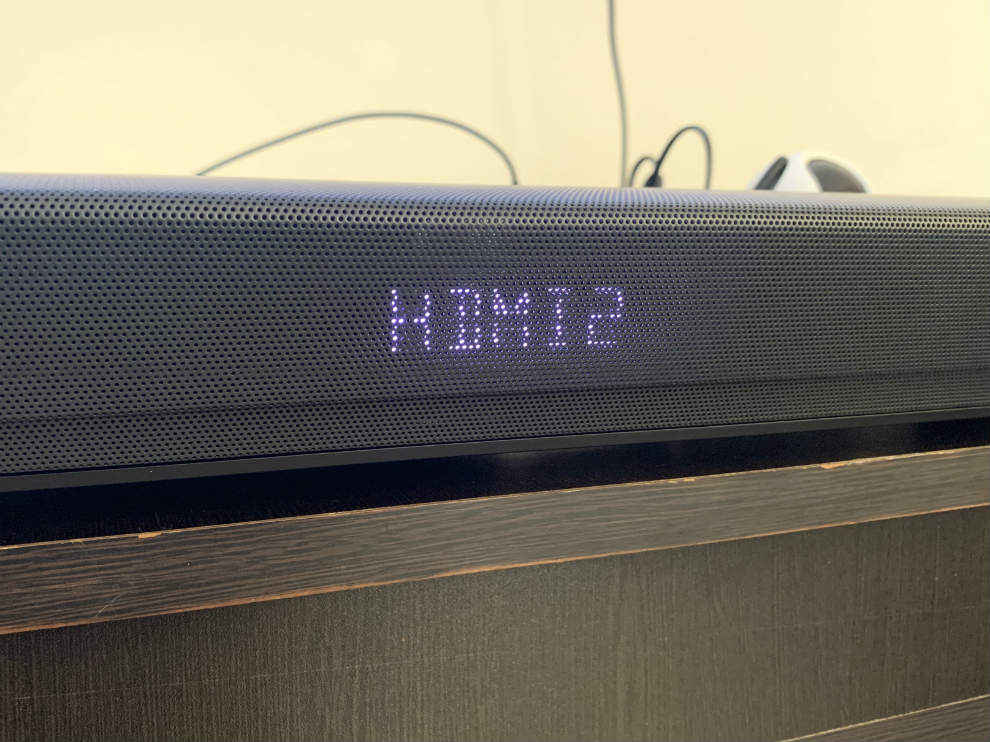
Movies
Holy smokes! As unassuming the subwoofer looks, its performance is just the opposite. Watch a movie like Greyhound on Apple TV+ and this subwoofer will smack you with the right kind of rumble when the ships hit the sea or when the bombing attacks start. Same thing for movies on Netflix like The Old Guard or even Extraction. These are movies mastered in Dolby Atmos and even though the surround sound is absent from the soundbar, it has good channel separation. Even the dialogues on these movies are a lot clearer than what we’ve heard on the Yamaha YAS 209. The Philips 3.1 soundbar packs in 320W of sound output and while that’s 80 less than the 400W found on the Sony HT-G700, it can get pretty loud and room-filling for the average-sized living room. To enjoy an action-packed thriller, one does not need to even reach the 80% volume of the soundbar. The soundbar has a volume range from 0 to 32 and for me, the sweet spot was between 13 and 19 based on the content.
Even dialogues for TV shows like Young Sheldon or Big Bang Theory or even documentaries are clean, clear and audible.
The soundbar has only 3 presets – News, Movies and Music along with a surround on and surround off. For each situation, the representing preset works nicely. If you like watching documentaries that don’t have much dramatic background music, then you can also consider the News preset as this one reduced the bass considerably.
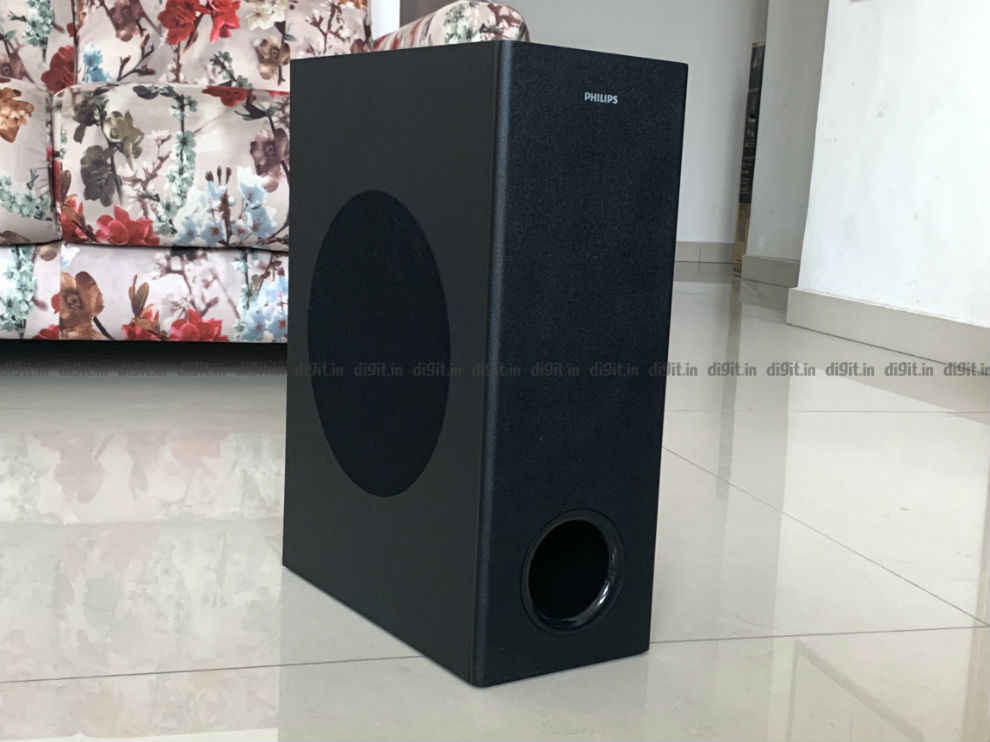
Even in a movie like Mission Impossible which has Tom Cruise swishing across the screen on a motorcycle, the channel separation from left to right was really good. Even the dialogues spoken during action sequences are extremely clear.
Be it 5.1 content from streaming services or Dolby Atmos, the output is punchy and clean in the Movie preset. For some, the bass may be too ever-present and in some cases overpowering, but that’s controllable on the soundbar. You can control the bass and treble settings on the soundbar.
Sitting 6 to 8 feet away from the soundbar, one can get an immersive experience. For me, the best channel separation and surround sound effect has come from the Bose Soundbar 700 (review). It gives you the illusion of sound actually coming from the left and the right. But then again, that soundbar is priced at a whopping 80K. The channel separation on the Philips 3.1 is almost at par with what we experienced on the Sony and that’s not a bad thing. Just don’t expect to be engulfed in surround sound. However, when the soundbar is at 60% or higher volume, you will get a good experience from the sound hitting you from below your TV.
Overall, for a movie watching the Philips 3.1 is a great experience provided you don’t expect to hear the plane flying above you.
Music
Music doesn’t need to have an ever-present bass or lows. It needs to strike you like a secret weapon, only making its presence felt when needed. Unless you enjoy songs like Dance Monkey by Tones and I, or Wicked Games the Parra for Cuva feat. Anna Naklab version or even some Daft Punk. In that case, the Music preset of the Philips 3.1 soundbar does fine. The vocals are punchy, instruments clear and the audio doesn’t crackle at high volumes.
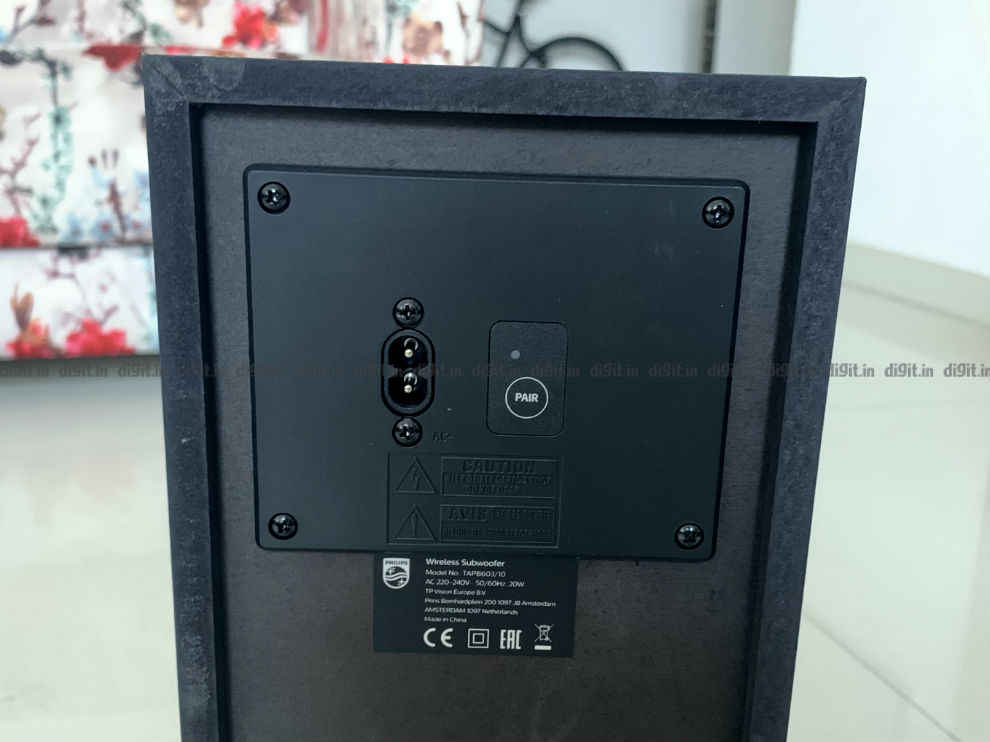
Whether you like listening to classical music, rock or even some pop, this soundbar does a good job. However, in my opinion, the music performance in terms of clarity and definition was a little better on the Yamaha YAS 209. If one had to compare, I would say the Yamaha does a much better job for music while the Philips has an edge for movies. The bass in music on the Philips is slightly more overpowering than I’d like.
Gaming
For gaming, we played Marvel Spider-Man, The Last of Us Part II (review), Ghost of Tsushima (review), God of War and Doom (review). Channel separation works well in all the games, especially when playing Spider-Man. You can hear the city pass you when swinging with chatter from the street clearly audible. Even the rushing of the wind when swinging is clear and adds to the immersion when gaming. Once again, don’t expect to hear the enemies from behind you but the overall gaming experience is immersive.
Doom’s is another game with a heavy metal soundtrack and the sound mixing in that game deserves special mention. With a punchy background score, unique sound effect for every weapon and the roars of demons, the game sounds quite good on this soundbar.
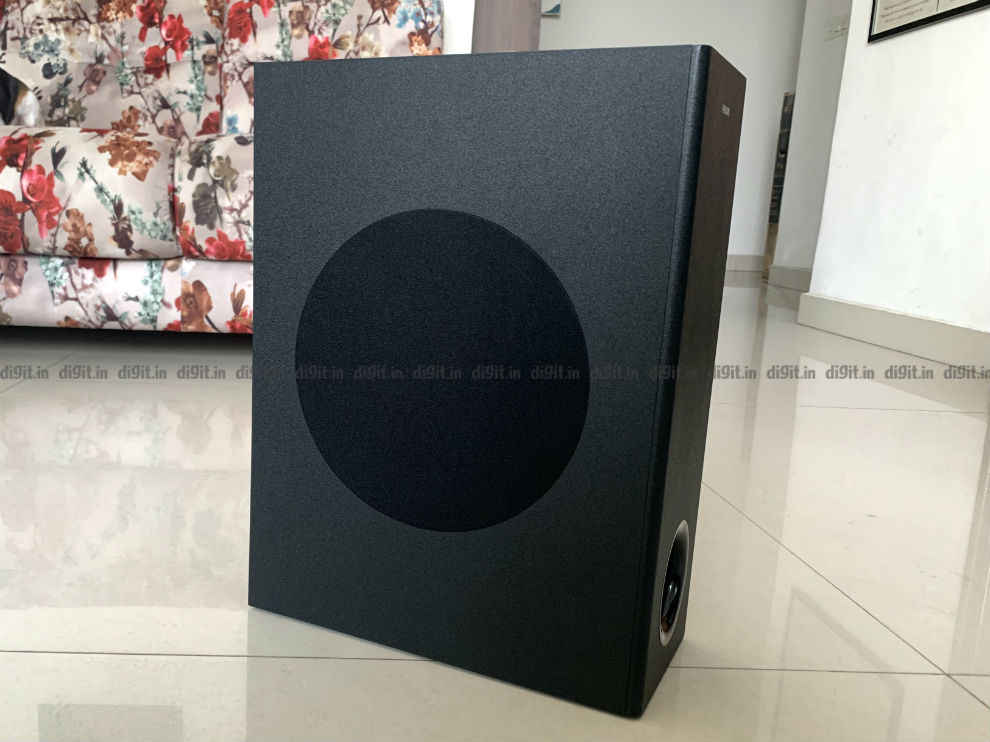
While the sound output from the soundbar is good I do miss the good old ‘Auto’ button on the remote control that changes the sound preset based on the content you are consuming. While you do get the display on the soundbar to prompt you every time the source changes from Dolby Atmos to Dolby HD or even PCM, there is no auto mode to change the sound presets based on the content being consumed.
The display on the soundbar has three levels of dimming, so that’s good and handy for those that want the least distraction while consuming content in a pitch-dark room.
So, what’s missing from the Philips 3.1 soundbar? Well, for one thing, I wish there was an app that could be used to control the soundbar. I find it very handy that I can control the settings of the Yamaha YAS 209 from the comfort of my phone which is always closer to me than the remote control. Once you connect the soundbar to the TV via ARC, you can control the volume using the TV remote control. But since the presets and soundbar controls need its dedicated remote control, you will have to keep it handy.
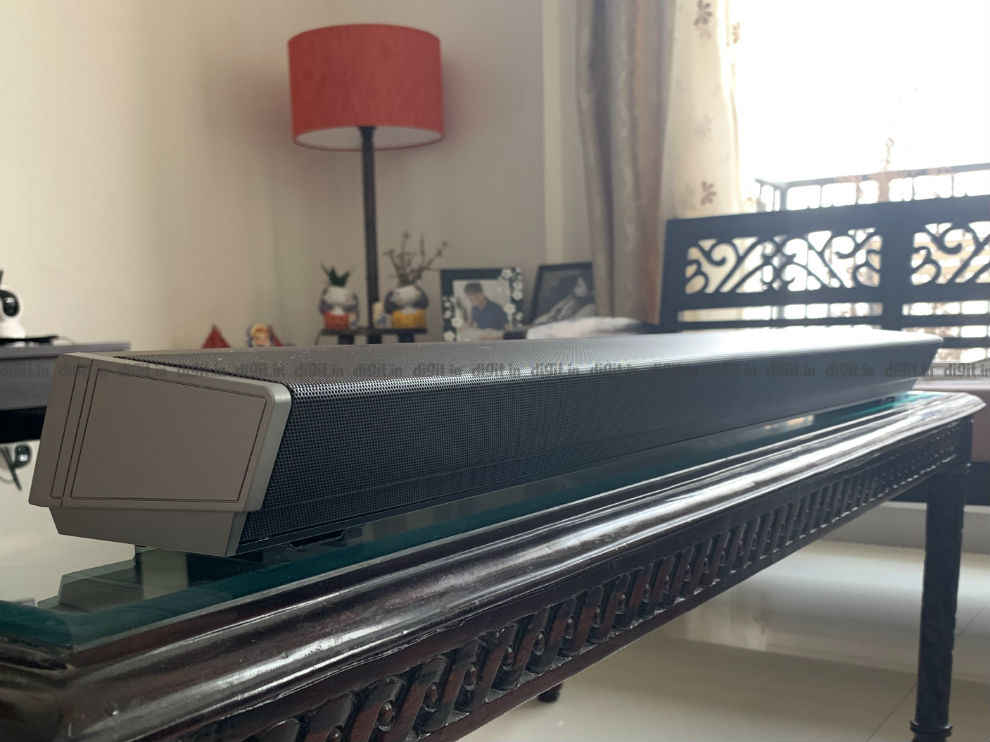
Remote control
Speaking of the remote control, the bundled remote control with the is quite well built and better than the one you get with the YAS 209. It runs on a button cell rather than AAA batteries so you may want to keep one in spare, just in case.
The remote control that comes with the Philips 3.1 soundbar has a traditional rectangular design but has a rubbery finish which adds to the grip. The rubber material is prone to scratches and dust.
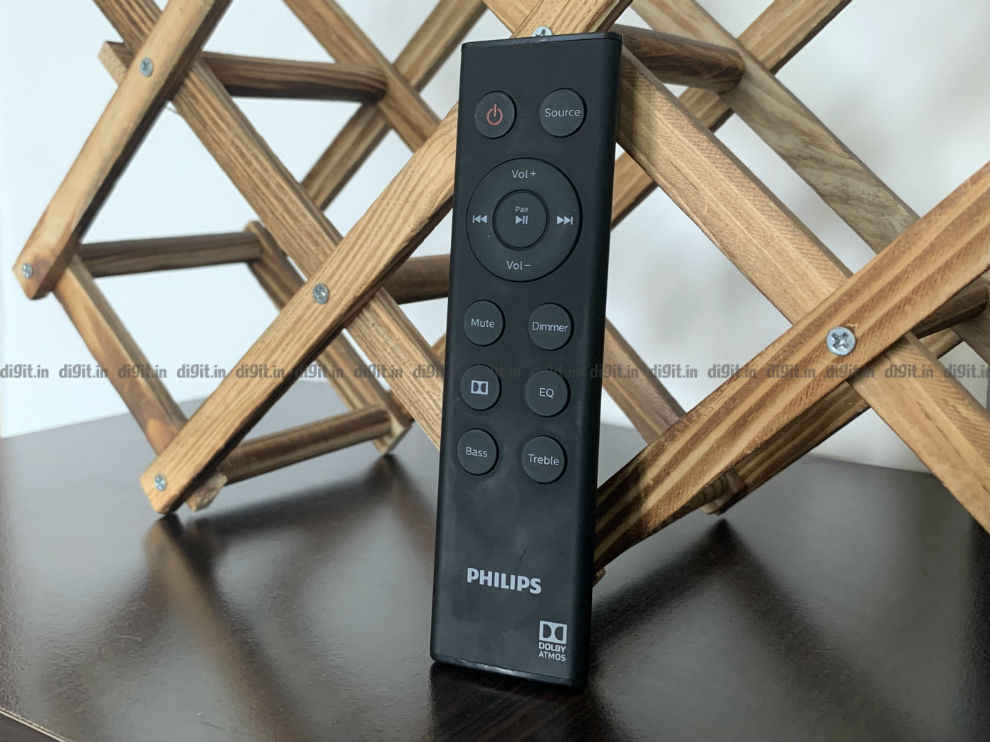
All the buttons are neatly laid out in two rows. On the remote control, you have the options for source, EQ – to switch between the sound presets, Dolby button to engage surround sound, buttons to control the treble and bass and dedicated playback controls along with volume controls. There is no “night mode” in the soundbar so if you want to watch a movie, you’ll have to keep the volume down or resort to headphones.
Bottom line
So, here’s the ever-important question. Should you spend 31K on the Philips 3.1 soundbar? What the Philips 3.1 soundbar has going for it is great sound output for movies, music and games. It has a unique design as well. It has two HDMI pass-through ports, but they don’t support HDR passthrough and that may be a downer for some. It has a simple and easy to use remote control. What it misses out on is some form of app support, internet connectivity and should have had some more settings in the form of a night mode, game mode, stereo and more. It can decode Dolby Atmos but don’t expect the sound to engulf you from all sides. If you have a budget of 30K, then you can consider this soundbar. It competes with the Yamaha YAS 209, JBL Bar 3.1 and the Polk Audio MagniFi Mini which are all similarly priced. The Sony HT G700 is more expensive by about 10K.
[ad_2]
Source link






